Although FC Köln aren’t one of Germany’s most successful nor glamorous football clubs, they have a history to be proud of, having won three Bundesliga and four DFB-Pokal titles.
After suffering relegation in 2018, Die Geißböcke won promotion back to the Bundesliga in April 2019. Since then, the club has managed to establish itself in Germany’s top flight.
After surviving relegation through the playoffs last season. The club appointed Steffen Baumgart as their new manager for the 2021/22 season. Steffen Baumgart’s impact on the club has been positive. There have been prominent improvements in the team’s league position and style of play.
This article will be a tactical analysis focusing on the tactics adopted by FC Köln throughout Steffen Baumgart’s first campaign. We will provide an analysis of the tactical principles within their play and focus on the key features that have put them in contention for European football.
Tactical Approach
This season, FC Köln have been switching between a 4-2-3-1 and a 4-1-3-2 formation. Both these systems suit playing a high block as you have a minimum of four players in the attacking third covering all channels of the pitch. This allows for a man orientated pressing system.
Both formations are beneficial for transition during the attacking phase of play with the 4-1-3-2 allowing FC Köln to be able to attack in a 3-1-6 formation. The 4-2-3-1 also enables you to attack in a 3-1-6 formation but a 3-2-5 is a more natural transition and an approach FC Köln tend to use.
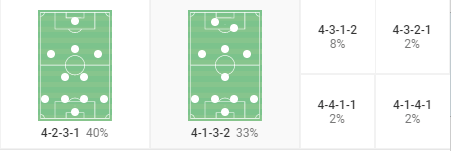
Since Steffen Baumgart took charge, FC Köln has focused more on retaining possession and attacking. This season, their average possession is 55.5% which is currently the fourth highest in the Bundesliga behind Bayern Munich, Borussia Dortmund, and RB Leipzig. Last season their average possession was 45.9%.
The team likes to position themselves high up the pitch, playing as much as they can in the opposition’s half. They like to attack through the wide channels and use their full-backs to provide width. FC Köln has provided more crosses than anyone else in the Bundesliga with a total of 580 — averaging 18.76 per 90 minutes.
Defensive Phase
A notable change in FC Köln’s approach under Steffen Baumgart has been the way in which the team presses. Germany’s gegenpressing style is famous, and FC Köln has wasted no time implementing a man-oriented interpretation of that pressing style.
In these two examples below, you can see how FC Köln look to set up when they attempt to stop a team from progressing the ball from their defence. An FC Köln player covers every Mainz and Union Berlin player. This is so all the nearby passing options are under immediate pressure and ensures they cannot get free and escape pressure if they receive the ball.
They aim to press high up to pitch and win the ball back. If they cannot win the ball back as close to the opponent’s goals as possible, their secondary aim is to win the ball back by making their opponents give up possession. You can see how each ball carrier only has two options, a pass back to the goalkeeper or attempt the long clearance up the field and risk giving up possession.
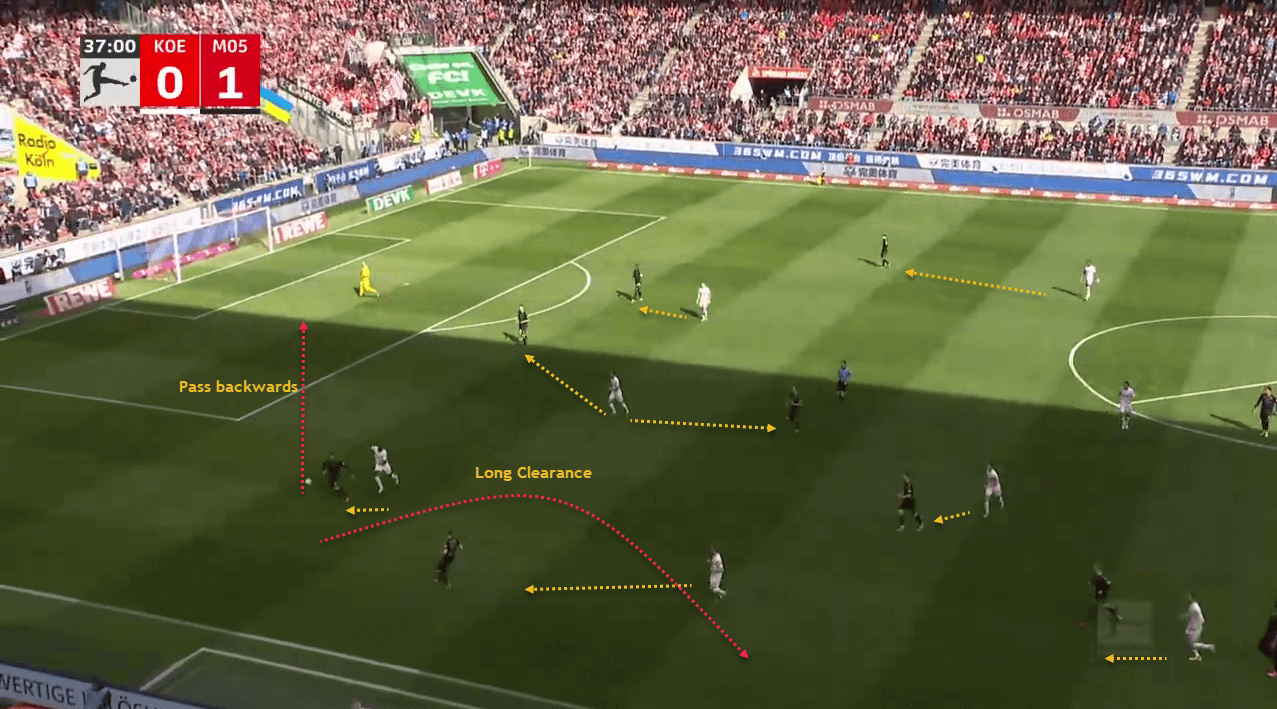
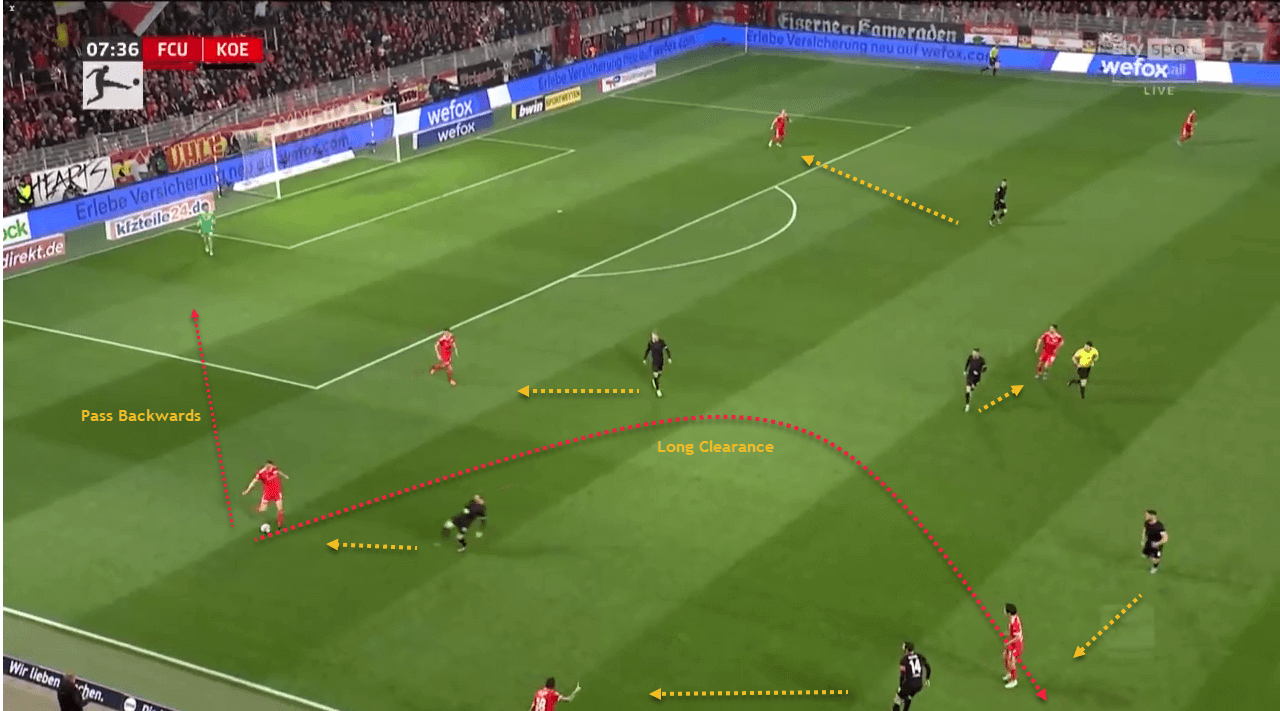
An FC Köln player will always look to press the opposition’s ball carrier aggressively. One notable pressing strategy used in the European game is for the surrounding players to follow the same man-orientation methodology. However, the man who leads the press just looks to limit the ball carrier’s options and will angle his run to cut off the passing lanes. This is because the team pressing is likely to be setting a pressing trap and will only want to win the ball in a certain area.
This is not the case with FC Köln, where the man who leads the press is moving aggressively to win that ball back at that moment.
When FC Köln are applying their press in the middle and defensive thirds, their pressing strategy differs. They still look to maintain coverage of the surrounding players but instead of one player focusing on just the ball carrier, they look to win the ball back immediately with multiple players pressing the ball carrier and blocking the space that surrounds him . This is like the space orientated approach used by Jurgen Klopp whilst managing Borussia Dortmund.
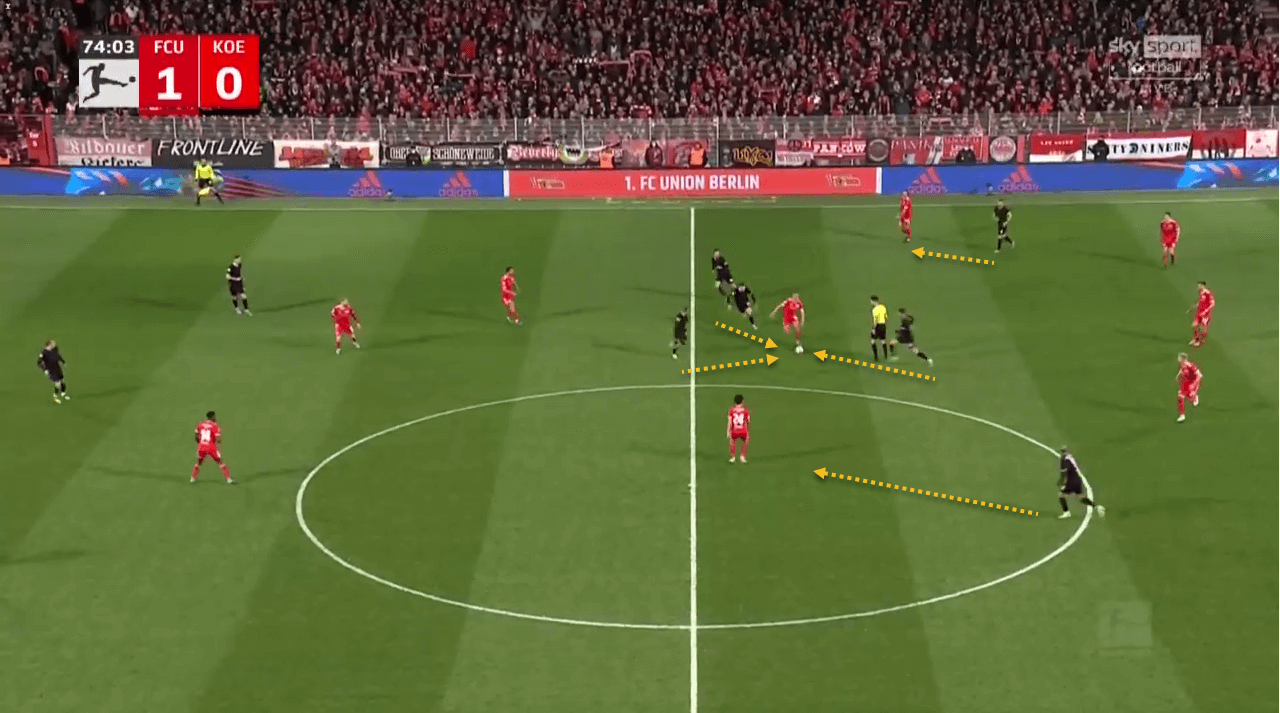
The pressing tactics implemented by Steffen Baumgart have been successful. The players have adapted well to this defensive phase of play. Attempting to win the ball back in this manner allows them to have more control of the ball. When comparing FC Köln’s pressing proficiency as a team compared to the other teams in the Bundesliga, I got the following results.
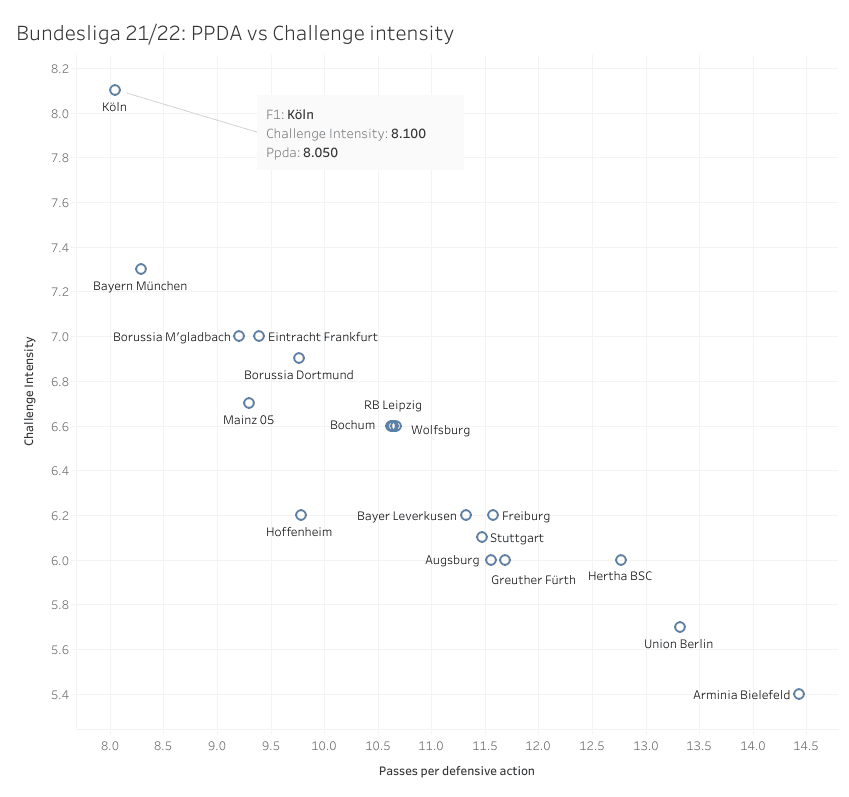
You can see from the data we have compiled that FC Köln has a highly effective pressing system.
Challenge intensity is determined by the number of times per minute during the opponent’s holding possession that FC Köln completes a duel, tackle, or interception. The data confirms FC Köln have the highest challenge intensity in the Bundesliga as they average 8.1 per minute. Passes per defensive action is determined by the number of passes the opposition makes before FC Köln looks to win the ball back. FC Köln allows the opposition the least number of passes in the Bundesliga at 8.05 passes per defensive action. This confirms that FC Köln press their opponents with more intensity than the average Bundesliga side.
When you analyse the pressing structure used by FC Koln last season under managers Markus Gisdol and Friedhelm Funkel, you can see the impact Steffen Baumgart’s positive approach has had on the team this season.
The data analysis below shows the PPDA against the challenging intensity for the 2021/22 season.
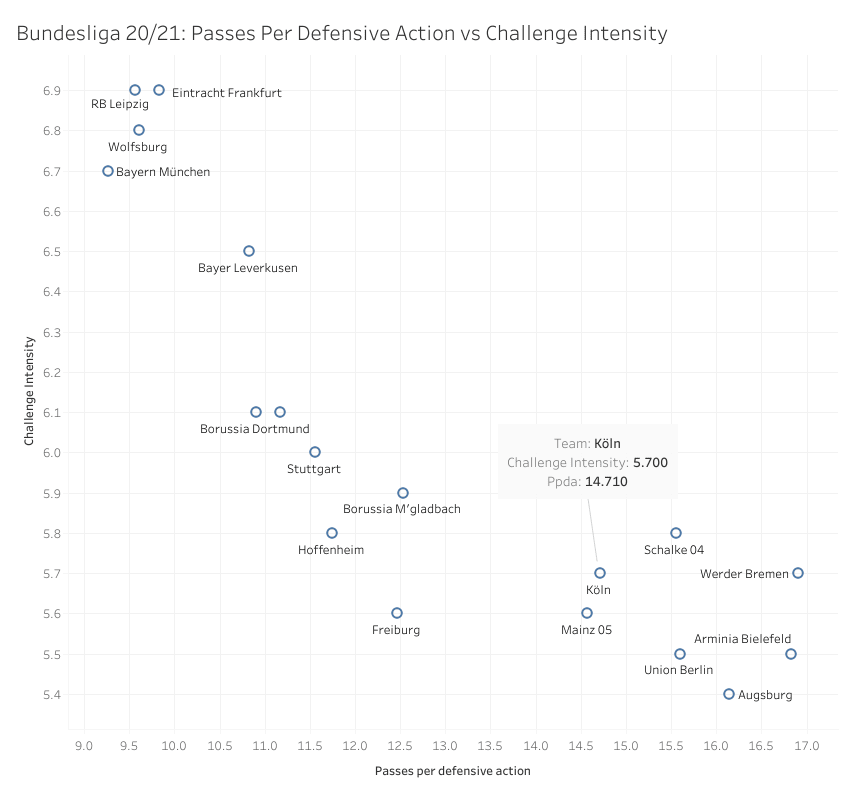
The data shows how less aggressive and intense FC Koln’s press was. Their challenge intensity was only 5.7 and they allowed their opponents 14.70 passes on average before they looked to engage and win the ball back.
Overall FC Koln was far less proactive with its approach. They kept the ball less and didn’t win it back as much.
Markus Gisdol was the manager until April and then after he was sacked Friedhelm Funkel took charge for the remainder of the season.
Markus Gisdol’s preferable formation was 4-2-3-1 but he was flexible with his formation and would often switch depending on the opposition. Friedhelm Funkel maintained a 4-1-4-1 approach in all but one of the eight games he oversaw.
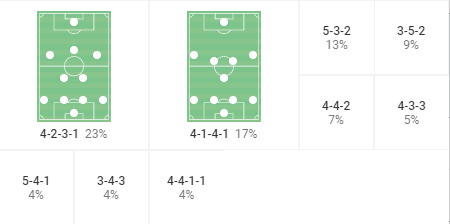
Under Gisdol and Funkel, FC Koln focused on keeping their shape, they sat deep and narrow and they wouldn’t press the opposition’s defence during their build-up. Instead, they looked to block the central spaces and force the play out wide.
When they won possession both managers would look to counterattack and get the ball forward quickly.
There is no doubt the team has prospered with the new defensive approach shown this season. The high emphasis placed on winning the ball back quicker has allowed FC Koln to be more purposeful during their attacking transition.
Attacking Phase.
Once FC Köln win the ball back, they like to transition to attack quickly and attack in numbers. This season has seen them focus on attacking from the wide areas and getting crosses into the box.
A common theme sees them overloading the edge of the penalty box centrally to create more space on the outside.
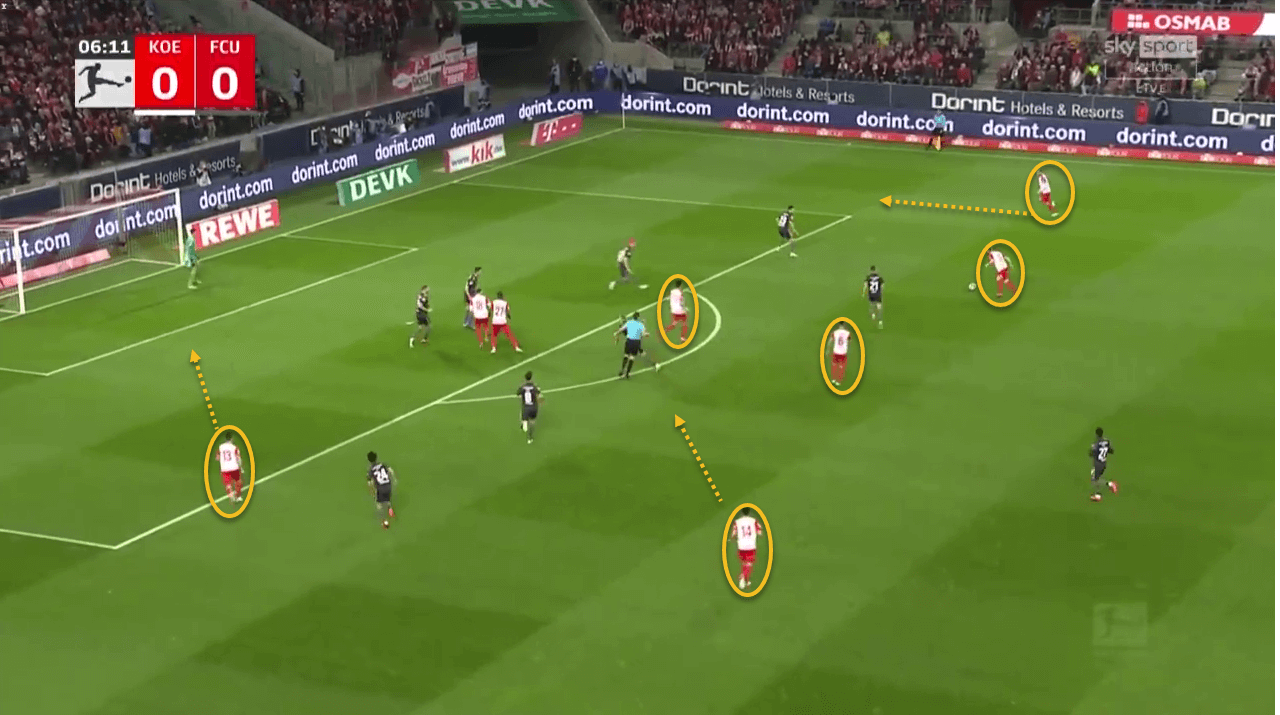
As this analysis confirms, FC Köln have completed more crosses than any other team in the Bundesliga this season. This is because of the attacking variety shown when in the wide areas. Overloading the pitch centrally is just one way they look to create and exploit space; creating overloads out wide is another attacking tactic used by FC Köln since Steffen Baumgart took charge. When they successfully press the opposition out wide, they will attempt to transition quickly down that channel.
In this example, you see how they create a 3v2 against Hoffenheim out wide. They exploit the space behind Hoffenheim’s wingback and stretch them vertically. Tactics like this are clever because Hoffenheim plays a 3-4-1-2 formation that transitions into a 5-3-2 when they are out of possession. FC Köln overloading the wide channels creates space behind the wing-back and pulls the centre backs out wide. This inevitably breaks the three-man defensive line and creates more space in the penalty area to cross to.
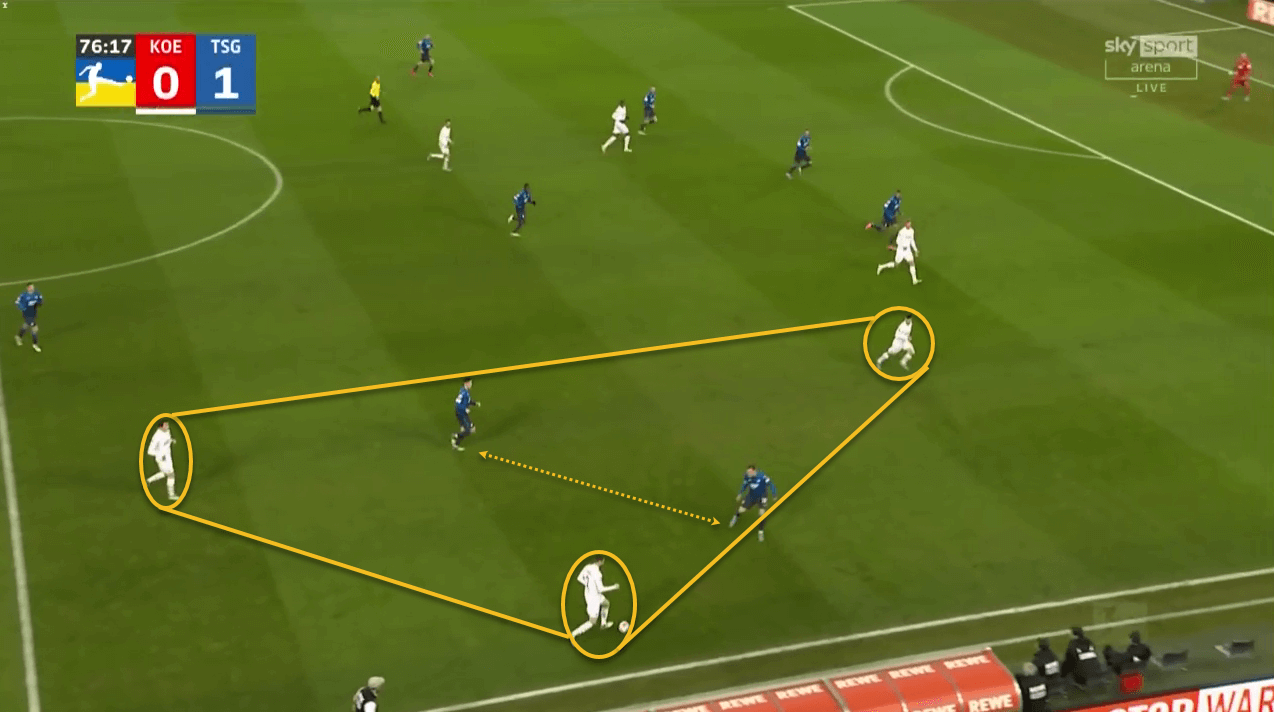
A very enjoyable aspect of FC Köln’s tactics this season is that their attacking approach is their philosophy. They attack the ball when they do not hold possession and when they regain it, they look to attack and control the match. It is not a one-off tactic for lesser opponents, and it does not matter who the opponents are. FC Köln look to dominate the ball and put their opponents under pressure, whether it be Bayern Munich or Greuther Fürth.
This is in the third minute of the match against Borussia Dortmund and another attack from out wide. This passage of play sees FC Köln attacking the penalty area with five players. Two players cannot be tracked by the Dortmund defence because the area they are attacking splits the centre back, leaving them with multiple players to try and mark.
The movements and the positional attacks from the crosses are well planned. FC Köln has two players in each of the half-spaces, two attackers occupying the space created between the centre backs and one player running from behind them.
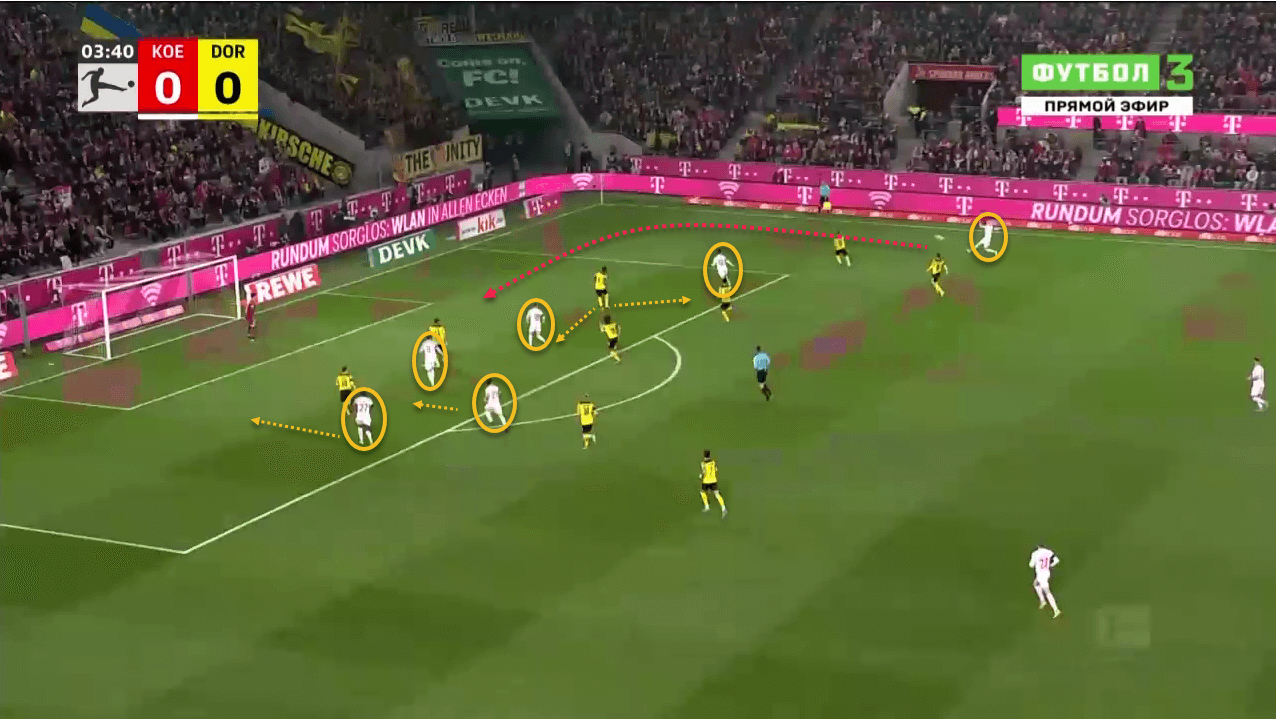
This allows the team to be able to mix up their attacking play from out wide. The players crossing the ball can cross to any zone across the penalty area. This makes the opposition defend with more numbers which allows FC Köln to push higher up the pitch.
Risk vs Reward
There is a high element of risk vs reward for the way Steffen Baumgart has FC Köln playing. When FC Köln attack, they look to expand the pitch vertically or horizontally, they push high up the pitch, attack in numbers, and when they lose the ball, they counter-press aggressively. The major risk to this play is the space they leave for their opponents to exploit when their attack breaks down. Their tactical aim of dominating the game leaves any transition from attack to defence ineffective.
This has proven to be FC Köln’s weakness this season. Once the opposition wins the ball or beats their counter-press they are vulnerable to counterattacks. They have conceded more goals than any other team from counterattacks in the Bundesliga this season, conceding seven goals.
This next image shows how Bayer Leverkusen are counterattacking against FC Köln. The amount of space surrounding the defence is too much and Leverkusen have too many options. The space in front of the defence allows them to turn and run at FC Köln, they have allowed space for Leverkusen to attack the right channel and the space left behind them is far too great.
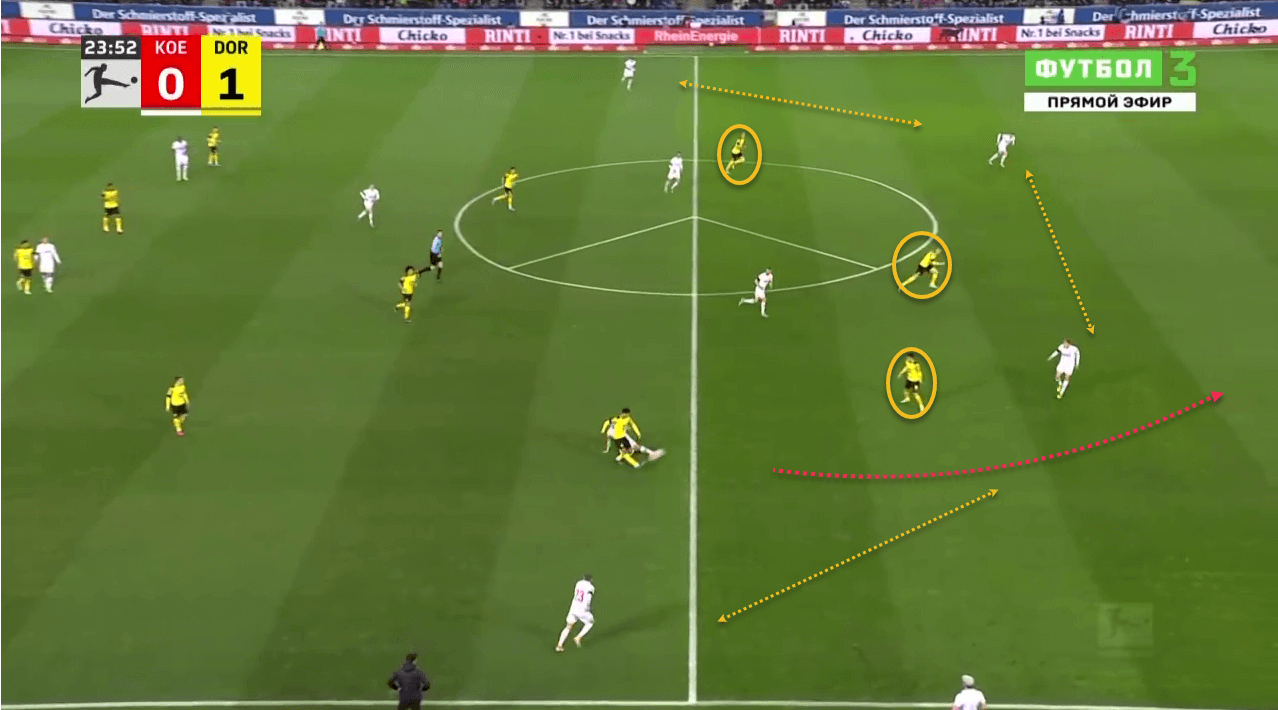
In the modern game, teams can prepare for a counter-attack in several ways. A wide centre back pushes wide to cover the area for a wing-back to push higher, a narrow full-back sits narrow alongside his two centre backs as the full-back on the opposite side pushes up or two centre midfielders remain deep and create a double-pivot in front of the defence whilst the wide players on both sides attack.
At times, FC Köln will structure their attack and keep one fullback from the attack and have him come inside alongside the two centre-backs. However, there are times it seems when FC Köln do not have any defensive structure in place for the possibility of a counterattack. When they play a 4-1-3-2, they are reliant on the full-backs to provide width. The full-backs play a fundamental part in how FC Köln attacks from out wide. This can leave big spaces between them and the centre-backs.
The image below provides an example of this. FC Köln lost possession of the ball just inside Borussia Dortmund’s half. Look at the space between each FC Köln defender because both full-backs are pushing high at the same time. This creates space in front of the centre backs, behind the centre backs and around the side of the centre backs.
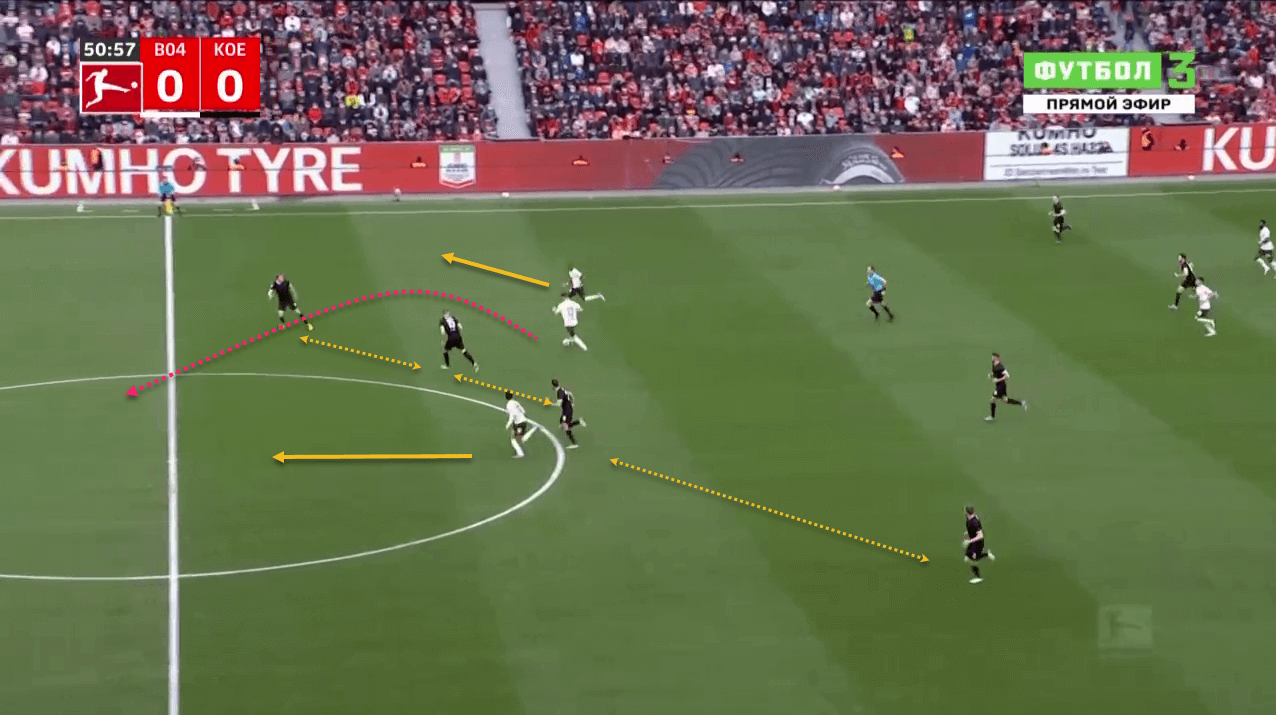
It makes FC Köln’s defensive third too accessible and too easy to penetrate when other teams counter-attack against them.
Individual Performance
Anthony Modeste has been FC Köln’s stand out performer this season. The 33-year-old is currently on fifteen league goals and is on track to have his second-best ever season in terms of goal output.
The data analysis below shows how well he is doing compared to the other goal scorers throughout the Bundesliga. He is the fifth-leading goal scorer in the league. If you take into consideration the quality of the player that surrounds him and the teams they represent, it shows you how good of a season Anthony Modeste and FC Köln are having.
He has an expected goals return of 12.32. The analysis shows he is outperforming his expected goals at this point in the season, but not at a rate that you can suspect a massive drop-off in form around the corner.
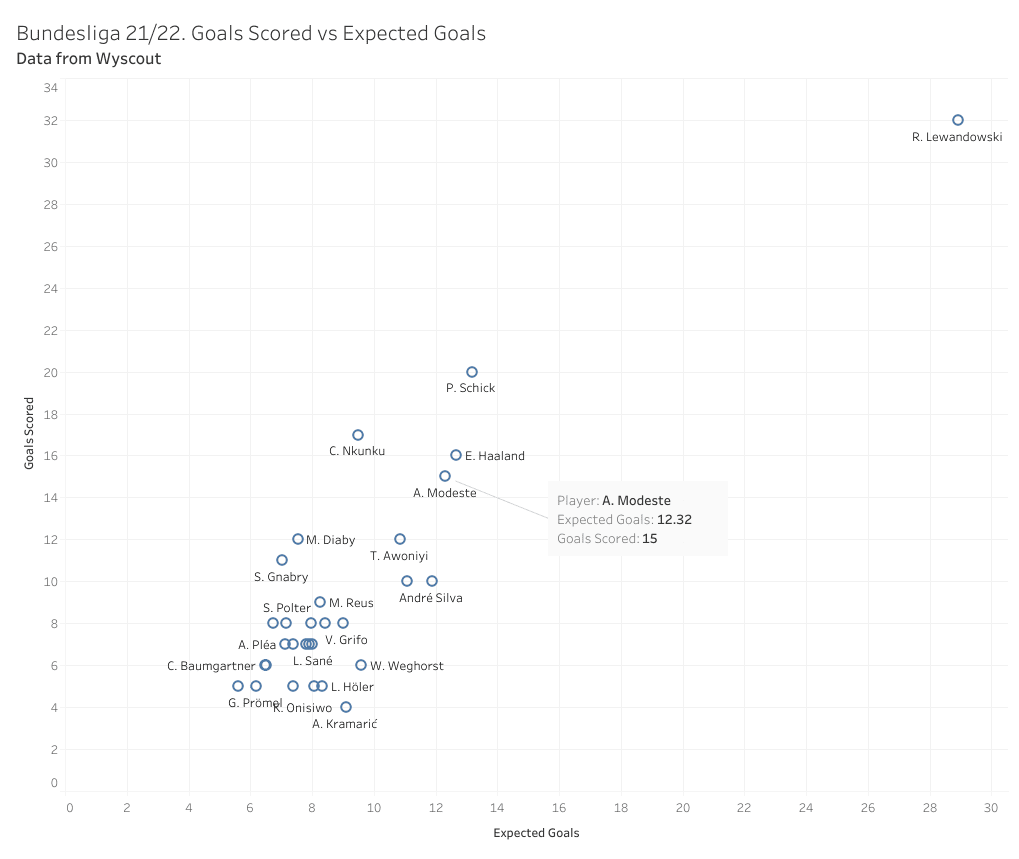
Steffen Baumgart’s revival of the team has been his ability to get the best from Modeste, who is the focal point for FC Köln’s attacking play. He is good at holding up the ball, he links up play and he offers good movement around the penalty area.
The Frenchman offers a particularly good aerial threat and is the scorer of most headed goals in the league with eight in total. The heat map below shows the movements and positions he takes up. You can see from this he focuses on being central and close to the goal; undoubtedly, Modeste is the key component of FC Köln’s wide play.
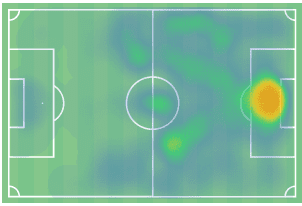
Conclusion
FC Köln have had a particularly good season in 2021/22, playing an exciting brand of football. They have made massive progress since Steffen Baumgart came in, with the German tactician remaining true to his principles. He has implemented the same approach that made him so popular at Paderborn.
With the club currently sitting in eighth place in the Bundesliga, one point behind Hoffenheim in sixth place, last season’s relegation battle is now a distant memory. So, how far can Die Geißböcke go in the future? With five teams still to play, and all five teams below them in the league, a return to European football could be on the horizon.

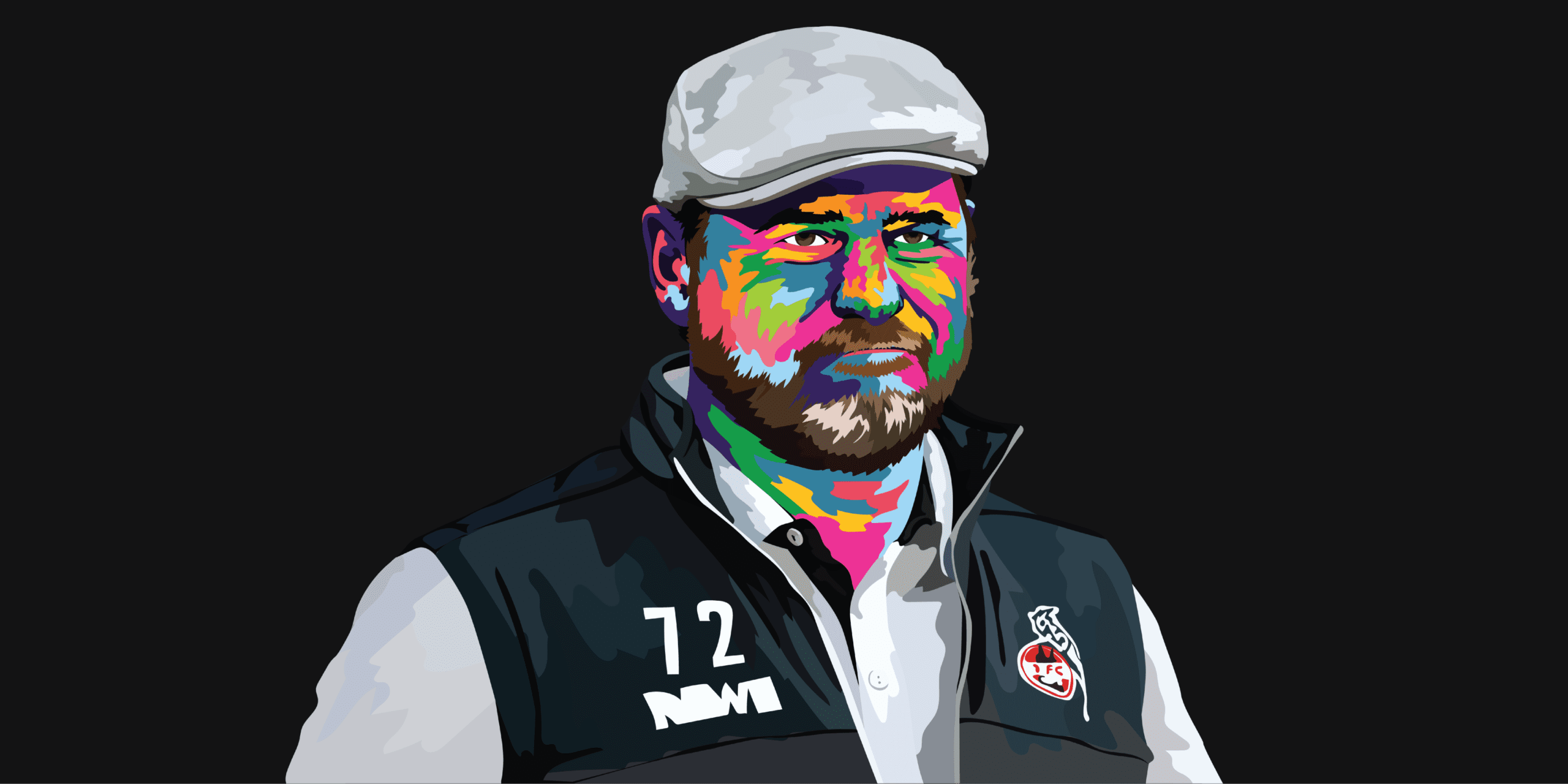




Comments